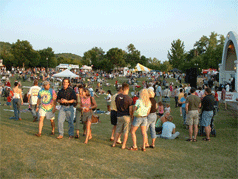

More of Wisconsin's
culture:
Hudson splits its seams
 |
|
Photo courtesy of Hudson Chamber of Commerce
|
Corn comes off the cob and into your fuel tank
Got grapes?
Meet two Wisconsin residents who have entered the international wine scene without leaving the state
The story of one man, the face of 200,000
Wrongly convicted in 1973, Maurice Carter spent decades confined to a prison cell before the Wisconsin Innocence Project helped set him free, nearly 29 years later
Welcome to Hollywood, Wisconsin
New bill creates incentives for filmmakers to capture life and scenery in the Dairy State
Ahead of the curve
Learning Laboratory Institute broadens educational horizons for Milwaukee youth
The grass along the riverbank is trimmed to a perfect half-inch of even, emerald green. The river looks sparkling clean, too. A woman pushes a stroller along a paved path past an older man in a hunting cap who is tossing bread crumbs to birds. Behind them on a sloping hill, Victorian houses crest on the horizon, built into the bluffs like permanent, elegant fixtures in some dollhouse community. Today it’s quiet aside from the gurgling river. It’s the middle of the day and everyone’s at work. In fact, it feels like a ghost town. The only sign of a more distant metropolis is the steady humming from the Interstate just a stone’s throw away.
Audiences, do not adjust your television screens. The picture is just fine. You are not entering The Truman Show. It just feels that way. Welcome to Hudson, the third fastest-growing city in Wisconsin.
According to the Census Bureau, Hudson’s population grew 29.5 percent from 2000 to 2005. Housing developments are springing up as schools begin to overcrowd. As a bedroom community to the Twin Cities area, Hudson plays the dual role of small-town charmer and near-metro exurb. What makes this city so special? It is bursting at its seams, and this bursting is indicative of a larger trend in Wisconsin, even America.
Idyllic, Isn't it?
People who live in Hudson are fond of it and with good reason. Traffic notwithstanding, Hudson is a mere 23 minutes from St. Paul. The streets are clean; the crime rate almost nonexistent. There are six golf courses nearby. The town seems to have more annual festivals than there are days of the year--the North Hudson Pepper Festival, for example. The biggest draw is the scenic St. Croix River that brings in boaters and campers in droves.
Mayor Jack D. Breault has lived in Hudson for decades and has been mayor 13 years. A portly, jovial man with a round St. Nicholas face, he’s been called “Hudson’s biggest cheerleader.”
“People love to live here,” Breault says, gazing straight into your eyes like a car dealer trying to drive home a bargain. “People live in Wisconsin, but they enjoy amenities of the Twin Cities and the scenic river. We know our residents care about Hudson because every time there are proposed changes—to anything—they fill the council room.”
According to a survey of about 4,000 households in Hudson conducted by the Survey Research Center (SRC) at the University of Wisconsin-River Falls:
· Four out of five residents rate the quality of life in their city as excellent
· Nearly 90 percent rated their own residence as excellent.
· More than two-thirds of respondents rated Hudson as good or excellent with respect to its geographic location, community appearance, community atmosphere, crime rate and sense of safety, the quality of its emergency services, and parks and recreation.
If only that were the whole story. With growth comes growing pains.
Meghan Hanes, a senior at UW-Madison, has lived in Hudson since she was in kindergarten. Her dad moved the family there with that same “small town conveniently located just outside the city” logic. These days, he’s looking to move out.
“My parents and their peers think it's growing too fast,” Hanes says. “It doesn’t have the same feel. There are just so many new developments. Every time I go home, there are new strip malls and bagel places.”
The majority of residents feel the pace of development in the city is moving too fast. Many residents fear that the sprawl along Interstate 94 will encroach upon protected parks and the St. Croix River Valley nearby. More than 60 percent of Hudson residents rate property taxes as poor or very poor. According to the survey, women, less-educated, long-term residents and those in low income brackets are most concerned about how this growth will affect them.
One survey respondent expressed oft-repeated concerns: “We are rapidly losing our safe, smaller town atmosphere and are going to become another spread out, generic city. We do not need more townhouses, apartments, and condos, nor do we need more franchises. We need to look into the future to make sure we’re expanding and developing carefully, so we avoid creating potential pockets of poverty with too many rental properties crowded in one area. Bigger is not better.”
Many small Wisconsin towns face this same dilemma. The appearance of town homes in a once single-family home dominated community can really shift the demographics and present challenges, such as exclusivity.
“Hudson started out as a small, upper-middle-class community, and it’s still very much a white conservative community. Sure, it might be getting more diverse, but it is by no means a diverse community,” Hanes says.
Breault says the city has a “progressive, yet conservative atmosphere.” He seems hesitant to say much more than that.
The demographics contribute to a “Pleasantville” vibe in Hudson. Almost 98 percent of the population is white. A high majority are Christian, either Lutheran or Catholic. The average home sells for a nearly $320,000. Homes in new developments near the Interstate skirt the half-million dollar mark.
“Growing up there, it was kind of this notion of a Utopia where everyone is well off,” Hanes says. “That’s not the kind of reality I'd want my kid to see. While growing up it was reality, but in hindsight it appears slightly surreal.”
After a moment’s pause, Hanes adds, “The community there right now would not be very accepting to changing the social dynamic of the city. I don’t think a minority resident would be unwelcome or have any hardship, that’s not what I mean. I just think if you polled the residents, they would say they are very happy with the status quo in Hudson.”
Eighty percent of residents would indeed say so. As long as things stay, pretty much, the same.
New Urbanism
Aside from the real or perceived lack of diversity, cities like Hudson are contributing to what some sociologists refer to as “New Urbanism,” an emerging design movement that melds together modern day concerns about urban sprawl, green spaces, safe neighborhoods, and individual character in a community. Since Hudson is trying valiantly to preserve its historic small-town nature, (“I’d say it’s the top concern for residents and the City Council,” says Mayor Breault), the city falls in with nationwide trends. Young professionals in particular are looking for a lifestyle package, not just a job, when they chose where to settle down. That’s what makes Hudson so appealing.
“It’s the festivals and the friendly neighborhood charm and the people sitting together for coffee and the parks and the safe feeling—it’s that total package,” says Heidi Rushmann, the museum director of the Octagon House, which is operated by the St. Croix Historical Society.
According to the U.S. Department of Agriculture, 49 million Americans live in non-metropolitan areas. They make up only 17 percent of the U.S. population but are spread out across four-fifths of the land area. For the first time, the 1990s were a prolonged period of rebound in small town population growth as more people moved into non-metro counties than moved out. Case in point: Urban Milwaukee, the largest city in the state, dropped below the Top 20 Largest U.S. Cities in 2005. Meanwhile, smaller cities like Hudson, East Troy, River Falls and Verona are splitting their seams.
Small towns do have a lot to offer. Whereas traffic, parking, soaring rent and property taxes, crime and pollution plague their urban counterparts, small towns can be havens for lower cost, lower stress and safer living. And more and more, they’re also the place the young and hip want to be.
Curb Appeal
If culture is what the young and hip seek, they can find it in Hudson. A stroll down the main drag of downtown displays all that represents a chic, affluent community — interior design and home accessories stores, a coffee shop, an independent bookstore, a Neapolitan pizza joint. The Phipps Center for the Arts, a block off the riverfront, recently underwent a $7 million renovation. The facility is now a regionally recognized art and theater center that rivals those in the Twin Cities.
Proximity to the Cities — but not quite in them — is the number one reason people say they live in Hudson. “The Twin Cities have a huge effect,” states John Potter, executive director of the Phipps Center for the Arts. “Hudson meets the criteria of a suburb for all practical purposes. We could technically be a suburb of St. Paul. That tells you all you need to know about who we are.”
CNNMoney even named Hudson as a contender in it's “Best Places to Live” in 2005, and it previously held a "Best Place to Retire" ranking. That’s in part because of all the golf courses and boating and fishing on the nearby St. Croix, but one of the critical factors in such a ranking is also affluence. The cities ranked often have a high price tag for residents. Many young professionals just starting out might not be able to afford the sticker shock.
“If you want to be totally honest,” Potter admits, “the schools in Hudson are growing fast, and teaching opportunities are here. But whether beginning teachers can afford to live here is another issue."
Rebecca Ryan is the founder of Next Generation Consulting, a market research firm that studies why Generation Xer’s work and live where they do. According to Ryan, “The question is: at what point is big too big? At what point do the scales tip, and Hudson goes from being this great place to live to being another bedroom community that can’t handle the growth?"
The City Council has put prohibitive measures on local land and housing development to help slow population growth. For now, Hudson remains a delightful weekend destination for travelers around the state and particularly across the border, from the Minnesota side of the fence. Apparently the grass is always a little greener in someone else’s small town.
“Everyone wants to be the last one in,” Potter says. “They want to shut that door behind themselves and say, that’s it, I’m here now, we can stop growing.”
 |
|
Photo courtesy Hudson Chamber of Commerce
|
home | alternatives | fulfillment | life change | climate | lifestyle
about | subscribe | contact | advertise | site map
_____________________________________________________________
(c) curb magazine 2006